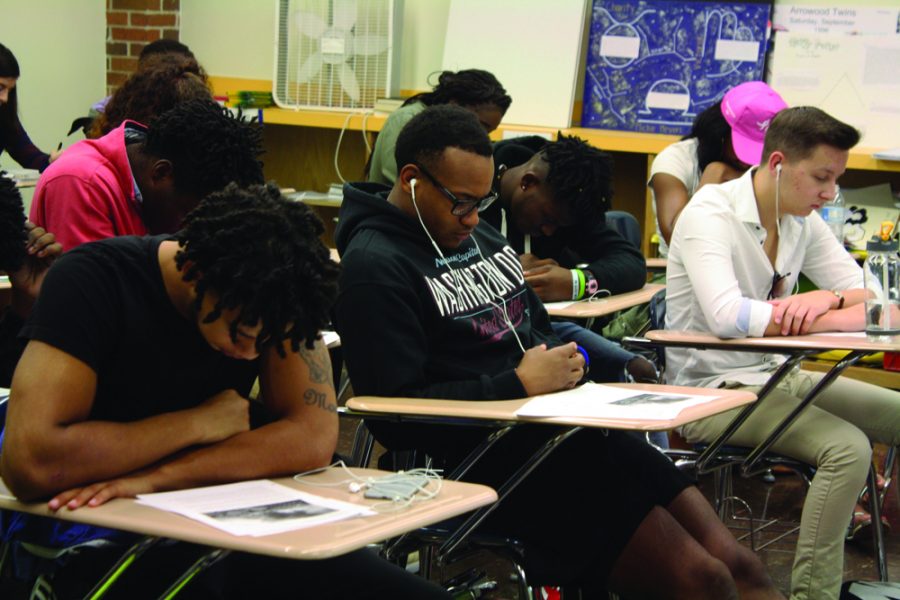It’s no secret that race in the United States is a topic of controversy. Within the past several months, movements like Black Lives Matter and #blackout, a movement for African-Americans to post selfies on social media, have begun to erupt around popular media and cult. Nor is it a secret that the country’s history and racism are intertwined.
These conversations take place more often in modern times, and manifest through a variety of means. One such way is the Black History 101 Mobile Museum, which will come to Columbia tomorrow, Oct. 28, to Hickman High School, although all members of the community are welcome. This includes the African-American Literature class at RBHS who will attend. Senior Tylee Schnake, a student in the class, said the number of diverse artifacts in the museum is proof of the struggle that African-Americans face and how people in the past overcame it.
“We all know that back in the day, blacks were treated horribly. We know that there was a lot of pain and suffering they endured — more than we’ll ever know or understand,” Schnake said. “It’s good that [the museum] teaches that. I think they should emphasize how, despite the oppression, poverty and fear, black heroes sprung up in so many different areas.”
The curator of the museum, Khalid El-Hakim, said this diversity of accomplishments is what inspired his varied exhibits.
“I design exhibits based on different themes such as sports, music, leadership, politics, religion, business and science,” El-Hakim said. “Having diverse exhibits provides an opportunity for audiences to be exposed to a very wide range of perspectives of the black experience in America.”
African American Literature teacher Randy Swift believes this emphasis is the most essential part of the exhibit because of the United States’ past, especially in regards to the past treatment of African Americans.
Swift believes the museum can be a great education opportunity for anyone.
“The artifacts in the mobile museum exhibit are pieces of history,” Swift said. “[El-Hakim has] a postcard signed by Rosa Parks and he has a document signed by MLK. Seeing some of the documents, especially like a [picture of a] slave in shackles, I think, adds depth to a picture when seeing that in person. I think there’s a certain amount of weight that goes into seeing an artifact rather than just hearing about it. The weight helps with more of an emotional impact, which helps the learning.”
Swift cites this as the main reason for why he will be taking his class to the exhibit.
“History becomes more relevant when you can see it, rather than just hear the stories,” Swift said. “Also, the coordinator of the mobile museum is an expert, and I believe in using any resources possible to help educate my students. I think seeing and possibly holding a piece of history has a better impact on the student’s learning.”
As El-Hakim’s museum grows and travels to new cities, he never loses sight of his goal to tell the story of his people. Swift sees the museum as a learning opportunity for his class.
“Seeing these objects, these stereotype-promoting things he’s got on display, can raise some awareness that racism isn’t just a problem today,” Swift said. “It’s been a problem for a very, very long time, and that’s possibly the reason why it’s still a problem today. I think being able to seeing some history in action can show people this perspective, that there’s more to society than what they possibly learned in high school and college.”
The Washington Post claims the current, volatile atmosphere concerning race has divided the United States today, and El-Hakim hopes to heal this fissure by widening people’s perception of African-Americans. He believes that, in the process, he may see progress in the race conversation.
“People are uncomfortable having discussions about race today, but it’s only through honest discussions about race that we’ll be able to make a difference in the way we see and interact with each other,” El-Hakim said. “Using historical artifacts to initiate these tough discussions, in my opinion, is one of the most engaging and transformative ways to address this challenge.”
Categories:
History museum to exhibit African-American accomplishments
October 27, 2016
1
0
More to Discover














































































Deabreon Cobbins • Nov 2, 2016 at 12:28 am
I strongly believe that is class is a good opportunity for students to get a better understanding on African-American history. Race equality is still a very big issue in America- many people have brought attention to this. Things like #BlackLivesMatter has a wide spread fan base if that’s what you would call it. I do agree with the fact that things such as the history of African Americans can be sort of a sensitive topic,